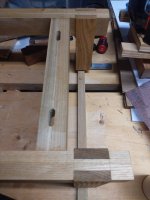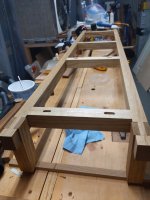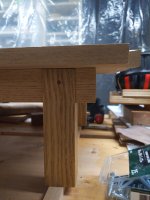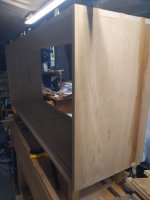I've been working on and off on a 5' wide cabinet on a base for a few months. The construction is box joints on the corners, a divider in the middle, and one shelf.
The base is a simple 6" tall affair with ~1 5/8" rails joined with pinned bridle joints. I've got 4 stretchers running between the front and back, about 1 5/8" square. The base attached to the box via 8 threaded inserts (2 per stretcher) that have some play for expansion/contraction.
The issue I'm running into is, the bottom of the carcass has bowed over the past few months and the base is not rigid enough to force it flat. If I throw a 6' level on it, there's about 1/8" of an inch in the middle. The top panel is still flat.
The carcass sides are already 3/4" thick, so I don't really have room to plane out the issue. I'm trying to figure out how i can increase the rigidity of the base so it will be able to bring the bottom flat. I was thinking to let in 1/8" thick 1/2" angle iron, but wasn't sure if that would be sufficiently rigid to resist the bending.
Does anyone have any thoughts/ideas on how i could get the base straightened out?
The base is a simple 6" tall affair with ~1 5/8" rails joined with pinned bridle joints. I've got 4 stretchers running between the front and back, about 1 5/8" square. The base attached to the box via 8 threaded inserts (2 per stretcher) that have some play for expansion/contraction.
The issue I'm running into is, the bottom of the carcass has bowed over the past few months and the base is not rigid enough to force it flat. If I throw a 6' level on it, there's about 1/8" of an inch in the middle. The top panel is still flat.
The carcass sides are already 3/4" thick, so I don't really have room to plane out the issue. I'm trying to figure out how i can increase the rigidity of the base so it will be able to bring the bottom flat. I was thinking to let in 1/8" thick 1/2" angle iron, but wasn't sure if that would be sufficiently rigid to resist the bending.
Does anyone have any thoughts/ideas on how i could get the base straightened out?






